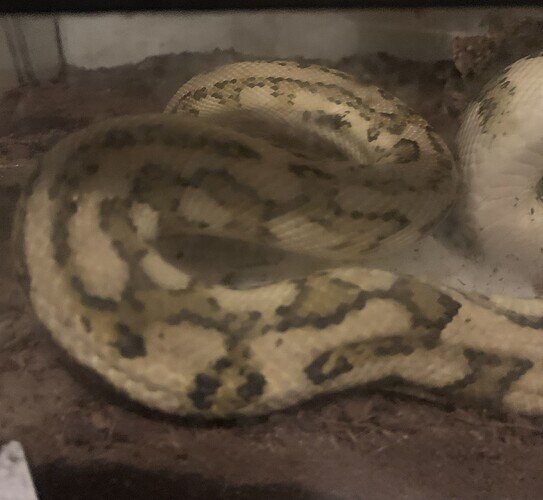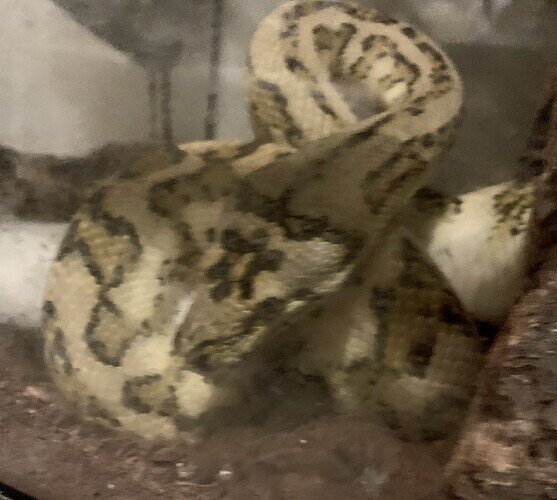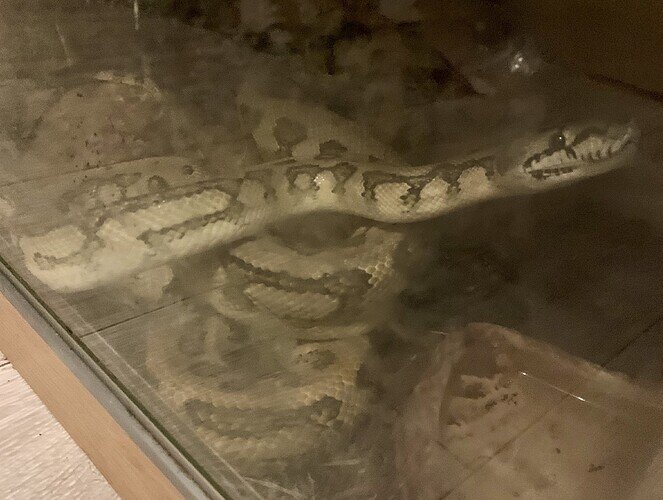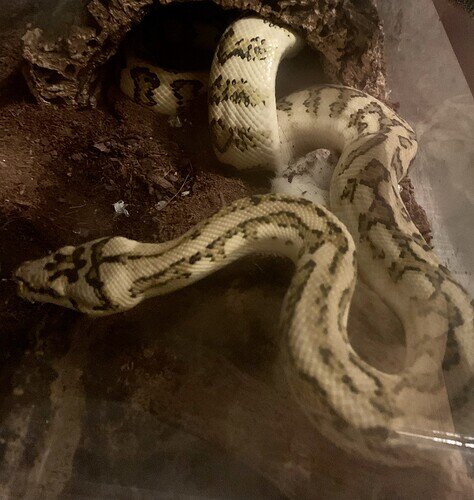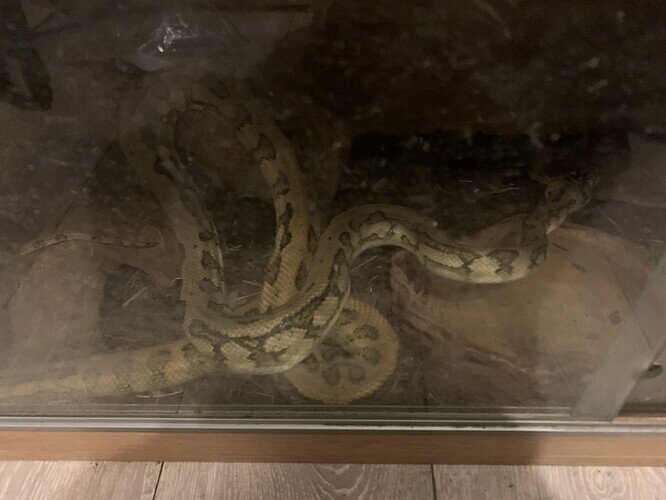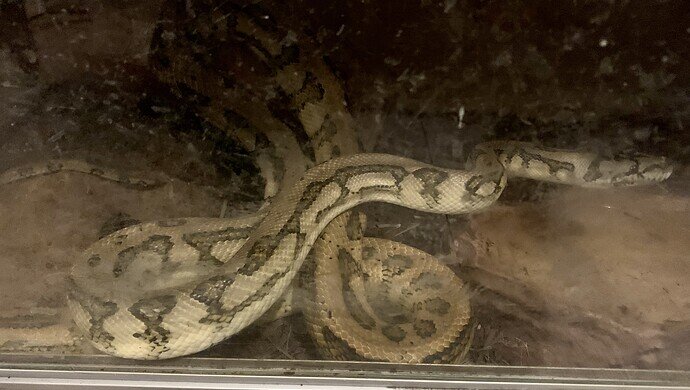Hi there this is my first time having any sort of python im used to corn snakes but I’ve rescued these two python. I think they are Jaguar Carpet Pythons but can you help me identify exactly what kind of carpet python they are please
Hi there this is my first time having any sort of python im used to corn snakes but I’ve rescued these two python. I think they are Jaguar Carpet Pythons but can you help me identify exactly what kind of carpet python they are please
yes, they look to be jungle jags. Very nice looking carpets! if you would like any help with them care or health wise feel free to ask.
Welcome to the community! we would love to see some of your corns!
Well my main aim is to get them into new homes where they will be cared for correctly that’s that most important thing for them and for me ![]()
All that can be definitely identified in them is that they are Jags, because that is a very distinct and clear mutation. Labeling them as anything beyond Jag (Jungle, IJ, Tiger, etc.) is nothing but speculation and would be unethical
Oops, didn’t mean to say jungle. thanks for correcting that ![]()
Arh ok I thought they were jaguar carpet pythons that’s as far as I got from doing abit of research on the internet. Ok they are around 6ft what size rats do I feed them and hour often and what size vivarium should they be in please
Also do people tend to sell them with vivariums or just the snake I’ve never done this before and like I said I’m not wanting to keep them I’m fostering them really until I can get them into their new homes which is asap
I’m making sure they’ve got water all the time and spraying them with mist and they have the correct heat pads in the tanks on all the time so am doing my best
a large rat every 3 weeks should be good. For housing, a 5x2x2 foot enclosure should work well. people usually sell without the cage. Just thought I would check, the heat pads aren’t inside of the enclosures are they? What is the temp?
Just thought I would ask; why do you want to get rid of them so quickly?
I took them on after the previous owner wasn’t taking care of them correctly so I’ve got them here with me so I can find them good homes with people that know what they are doing and take proper care of them as they aren’t the snake of my choice
I will check about the heat pads what temperature should they be on please and should they be on all the time
They are such beautiful snakes as well but I’ve only ever had a corn snake which is just alittle bit smaller then these two ![]()
So I know a bit about snakes but not this type and I’m a big lover of all creatures great and small hence why I only want the best for these and that’s to find them homes where the people know how to take care of them properly and give them the best life as they are stunning and deserve it ![]()
In that case one is in a viv that’s way too small for it and from what I can see the heat pads are inside the enclosure and they need a really good clean out bless them so will do that tomorrow plus they’ve been fed medium rats every 6 weeks so I’m definitely glad I took them in. With them not being fed correctly am i right in thinking they should be thicker in body then what they actually are?
not necessarily. from what I can tell they seem to be in not too bad of body condition. could you get an above picture of them in a straight line and a second picture that looks down the back of the snake to see the shape of the body. I would definitely get the heat mat out of the enclosure and onto a thermostat. there are lots of videos online about how to set up heat mats properly.
For a crash course in carpet care I strongly recommend you check out the Morelia Python Radio podcast. They have 13 or 14 years worth of episodes and I know they have covered basic husbandry a few times
Rapid fire highlights for you:
- If you are not already aware, the Jag gene has an associated “neuro” behaviour like what we seen in Spider with balls. SO do not immediately panic if they do weird things with their heads (twirl, wobble, tilt upside-down, etc.)
- If you have the space and ability, cages are better but you can use tubs if necessary. For a 2m snake, a CB70/FB40 is going to be a little cramped but it is fine short-term. Long-term, you want something like a boa tub which I think are the CP110/FB90 (but do not quote me on that). If you are going with a cage, minimum would be 120cm x 60cm x60cm. A 180cm x 60cm x 60cm would be better
- I would scale back the size of the feeder to a medium rat, but every 2-3 weeks is fine. Their current body condition is fine. These are arboreal animals so they do best when kept trim and fit and able to climb, not fat and on the ground
- Given the time of year (at least here in the northern hemisphere) they are good with a winter cool down which would also help in terms of feeding because you can safely stretch time between meals. They should still receive heat during the day but you can shut it off at night. Given what I can see of their body condition in the pics (kinda hard to tell because of the state of the glass) they could safely go six to eight weeks before being fed next. If you do opt for this, I would only use a small rat to feed them when you break the fast
- In the vein of them being arboreal; give them something to perch up on. A box, a hide, a branch - anything that gives them the opportunity to feel like they are a bit off the ground. They will appreciate it
- Stop spraying them, just make sure they have a good source of water to drink
- If a heat pad is all you have then, as advised, pull from inside the cage and switch to outside and on a thermostat. If it is possible, a RHP would be a better heating option. They really prefer to bask underneath the heat. But as I said, if needs must, a heat pad is fine
.
.
May I ask where you are located? I know quite a few carpet folks so I might be able to put you in touch with someone near you that would be willing to chat you up in more detail
I don’t know why everyone is saying to get the heat mats out of the vivarium. Heat mats must be uncovered (so inside the vivarium and on top of any substrate) otherwise they are ineffective and pose a fire risk. If they aren’t yet controlled by a thermostat then leave them outside until you set that up to avoid burns, but afterwards move them back inside. Otherwise, all of the advice given here is good. If you’re only keeping them very temporarily a 4x2x2 with heat mats is fine, but if they’re with you for longer you’ll want at least a 5x2x2 with overhead heating.
I’m not sure why you’re saying this, or what you’re referring to that may be causing this confusion.
Heat mats/heat pads for reptiles should NEVER be used inside the enclosure, regardless of using a thermostat or not. They absolutely do not pose a fire risk being on the outside of the enclosures.
Yes, you need an air gap, but they aren’t intended to go inside of an enclosure full stop.
Also
No, do not use a heat pad without a thermostat period. You put the animals at extreme risk of temps up to easily 130f, which can be life threatening and cause neuro issues due to the heat. It should be outside the enclosure, with a thermostat. Not inside period. And not without a thermostat.
I’ve always kept my heat mats inside my vivariums. If it goes underneath the viv then it has to get much hotter to heat the enclosure and does pose a risk. It also gets much hotter under the substrate than on top. Thats the standard over here at least, I’ve never spoken to someone who recommended I keep it outside, and googling has confirmed most guides say do not cover the mat. I said to keep it outside without a thermostat because no heat at all is even more dangerous than a hot spot the snake can move away from. Obviously get a thermostat asap and remove it if its getting hot enough to burn.
There are several other forum members here from the UK that do not tell people to put heat mats inside their enclosure. @ghoulishcresties being one of them.
Saying it shouldn’t be covered doesn’t equal put it inside. It means put it on the outside and don’t have it sandwiched between another material. That’s when you are at risk of a fire hazard.
Also not having any heat isn’t more of a risk than potentially cooking a snake due to uncontrolled heat, definitely disagree there. Most households are not cold enough that the snake would have detrimental effects from no hot spot while waiting for a thermostat.
